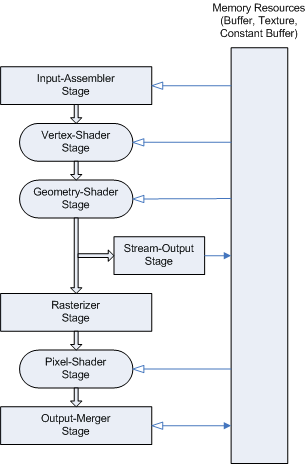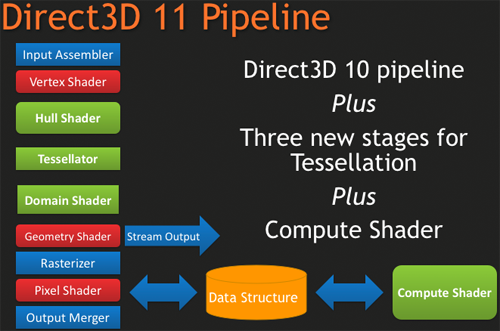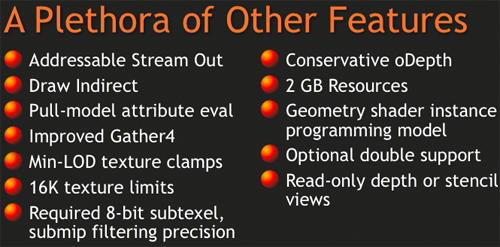Introducing DirectX 11: The Pipeline and Features
This is DirectX 10.

We all remember him from our G80 launch article back in the day when no one knew how much Vista would really suck. Some of the shortfalls of DirectX 10 have been in operating system support, driver support, time to market issues, and other unfortunate roadblocks that kept developers from making full use of all the cool new features and tools DirectX 10 brought.
Meet DirectX 11.

She's much cooler than her older brother, and way hotter too. Many under-the-hood enhancements mean higher performance for features available but less used under DX10. The major changes to the pipeline mark revolutionary steps in graphics hardware and software capabilities. Tessellation (made up of the hull shader, tessellator and domain shader) and the Compute Shader are major developments that could go far in assisting developers in closing the gap between reality and unreality. These features have gotten a lot of press already, but we feel the key to DirectX 11 adoption (and thus exploitation) is in some of the more subtle elements. But we'll get in to all that in due time.
Along with the pipeline changes, we see a whole host of new tweaks and adjustments. DirectX 11 is actually a strict superset of DirectX 10.1, meaning that all of those features are completely encapsulated in and unchanged by DirectX 11. This simple fact means that all DX11 hardware will include the changes required to be DX 10.1 compliant (which only AMD can claim at the moment). In addition to these tweaks, we also see these further extensions:

While changes in the pipeline allow developers to write programs to accomplish different types of tasks, these more subtle changes allow those programs to be more complex, higher quality, and/or higher performance. Beyond all this, Microsoft has also gone out of its way to help make parallel programming a little bit easier for game developers.










109 Comments
View All Comments
Hrel - Sunday, February 1, 2009 - link
This is one of the most poorly written articles I've ever read on anandtech. It's like the author couldn't organize his thoughts properly. Also, the speculation was riddled with subjective assumptions. I'm not sure if the author just doesn't know this topic very well or if he hadn't slept in 3 days, but this could have been done much better. Great topic though, and interesting subject matter.GourdFreeMan - Sunday, February 1, 2009 - link
Derek, the DX10 geometry shader was never really intended to do tessellation, and really should not be thought of as a generalized tessellator. It was designed to offer a generalized hardware implementation of vertex effects such as skinning, vertex blending and tweening (see the dolphin demo in the DX SDX for what I am refering to here).If it becomes desirable at some point in time in the future to offer fully programable tessellation, then vertex shader, hull shader, tessellator, domain shader and geometry shader could all be merged into another compute shader earlier in the pipeline to do generalized vertex manipulation.
Of course, it is also possible that the existing tessellator will prove more efficient as fixed function hardware, and only minor functionality improvements will be added.
eXistenZ - Sunday, February 1, 2009 - link
HelloI just wanted to add, that ATi graphic cards have tesslator included since Radeon 8500, but i can be wrong...
I remember "Truform" technology, which is working in Serious Sam, or Return to Castle Wolfenstein, and Counter Strike 1.6 (it is not working now in Counter Strike).
I want to know, if author of this article forgot about it, or im wrong about this technology.
Sorry for my english, im from Slovakia :)
haukionkannel - Sunday, February 1, 2009 - link
There has been a tessalation unit in ATI cards for some time. It's not the same as is reguired in DX11, but guite near. I think that it was mentioned in the article...From what I know is that DX10 has been slow because in most games it's just dx9 with some clued features from dx10 above it. With pure dx10 codepath it would have been faster, but that would have left all those XP-customers out, and would not have been sound economically...
The author hopes that Win7 win encourage the transfer from XP, so there will be larger amount of DX10 and DX11 platforms. So it would become enonomically possible to make DX11 based games (just leaving out some pure DX11 features so that older dx10 cards could handle the games.) So actually when dx11 games comes out, they would be actually first to make use of all dx10 features...
Well there are so many dx9 machines in the world that even that will take time. So we will see poor dx10, dx11 performance until the XP customers are not needed by game companies, and even then there are those pure console transfers without any optimization like GTA...
I hope that "Chattered horisont" from Futuremark shows what DX10 can really do. It is goint to be pure DX10 game, so it can use advantages that dx10 can offer. On the other hand it can be next Crysis that looks really good, but makes your hardware moan for more power. We will see...
yyrkoon - Sunday, February 1, 2009 - link
"On the flipside, DX11 will be able to run on down level hardware."Um . . . Eh ? English ?
"This may not significantly speed up the graphics subsystem (especially if we are already very GPU limited), but this does increase the ability to more easily explicitly massively thread a game and take advantage of the increasing number of CPU cores on the desktop. "
... and significantly slow things down even further.
" These code resources are huge and can be hard to manage without OOP (Object Oriented Programming) constructs. But there are some differences to how things work in other OOP languages. "
I think you would find many experienced programmers who would say that OOP is a way of programming, not necessarily a language type, and I would have to agree with them. Now if you mean languages that *support* OOP, then sure, I can live with that.
Also, one other minor thing that kind of bothers me. You speak of Directx 6, but was Directx 6 an actual redistributable ? I definitely do not remember it, but I *do* remember Directx 5, Direct 7, 8, . . . and even that thing MS claims never existed . . . WinG.
DerekWilson - Friday, February 6, 2009 - link
down level hardware == hardware that meets a lower DX spec (like DX10 hardware).allowing games to be more mulithreaded using a fine grained synchronization scheme ala DX11 should not slow things down if developers take advantage of it correctly (which will be much easier than doing your own management here).
yes i did mean languages that support the OOP model.
DX6 was a Win98 thing ... it existed and actually was (iirc) the first version of DX to be hardware accelerated ... at least that's how I remember it.
DX4, on the other hand, never existed -- MS skipped from DX3 to DX5.
frozentundra123456 - Sunday, February 1, 2009 - link
I was initially unhappy with both Vista and DX10. However, I have come to accept Vista, but dont know if it is that much improved over WinXP. I only have Vista because I bought a new computer with that OS intstalled. I dont really know of anything I do with Vista that could not be done with XP. The only advantage to Vista is that it is supposedly more secure than XP, but I never had any major security problems with XP, nor have I had any with Vista.DX10 is still more of a disappointment to me. It requires too many resources and does not seem to offer corresponding improvements in visual quality. Nearly every game I have that is DX10 compliant, I run in DX9 mode because the performance improvement in DX9 more than makes up for the slight visual improvement with DX10. (Yes, I know I need a better graphics card.) I have an HD2600 pro, which was supposedly a "mid range" DX10 card when it came out, and it is virtually worthless for trying to play in DX10 mode, as I stated above.
I wonder if DX9 will still be supported when DX11 comes out. If not, they had better make DX11 run better on low to midrange hardware than DX10, or there will be a lot of unhappy users.
epyon96 - Saturday, January 31, 2009 - link
Since Derek claims that Direct X 11 is simply a superset of Dx10, why does Microsoft release it simply as 10.2 instead? I am curious what makes a Direct X version and what determines an incremental move forward.ltcommanderdata - Saturday, January 31, 2009 - link
I'd like to know that too. Since to me DX9.0c (SM3.0) seems to have been a pretty major step forward from DX9.0 (SM2.0), even a whole new shader model, yet it was only given a letter subscript. It should have at least been DX9.1.My cynical view? It's all marketing and Microsoft appeasing hardware vendors for their own benefit. For example DX8.1 was supposed to be a decent step forward, going from SM1.1 to SM1.4 with longer shaders and other features. Yet nVidia refused to support SM1.4 and managed to convince Microsoft to call SM1.3 DX8.1 compliant even though it's closer to SM1.1 than SM1.4. My suspicion is that Microsoft agreed with nVidia, because at that time nVidia was making the GPU for the XBox and Microsoft needed them.
A similar situation occurred with DX9.0c and SM3.0. This time ATI wasn't going to offer immediate support for SM3.0 in their GPUs. So in order for ATI's X8xx generation to not look so far behind, SM3.0 was only marketed as DX9.0c instead of DX9.1 or something more major. Why would Microsoft appease ATI? Conveniently, ATI was making the GPU for Microsoft's next-gen XBox 360, so Microsoft needed them.
This might not actually be true, but it's interesting that the swings in XBox GPU choice corresponds with Microsoft's degree of emphasis on DirectX capability.
In the case of DX11, I think there is sufficient new capabilities with Tessellation and Compute Shaders to justify a major number increase. I believe what Derek means is that DX11 is a superset of DX10 in the same way DX9 is a superset of DX8. They both offer backwards compatibility. In contrast, DX10 is not compatible with DX9 and Vista actually has separate DX10 and DX9 APIs (and third Vista specific DX9.0L) while DX8, DX7, etc can run on the DX9 API.
GourdFreeMan - Sunday, February 1, 2009 - link
Microsoft originally had some soft guidelines in this respect. Letter releases were to represent minor changes in the API such as the range and precision allowed for constants, max number of loop iterations in pixel and vertex shaders, etc. Point releases would permit added functionality to stages of the rendering pipeline. Version releases could include changes to the rendering pipeline itself. In practice, point and letter releases have been to support vendor-specific functionality, and version releases have set a baseline for all vendors.Microsoft's guildelines fit for all DirectX changes except 9.0c, which was really a vendor-specific change to fit the nVIDIA 6000 series hardware. (ATi did not have SM3.0 cards until its next hardware generation).